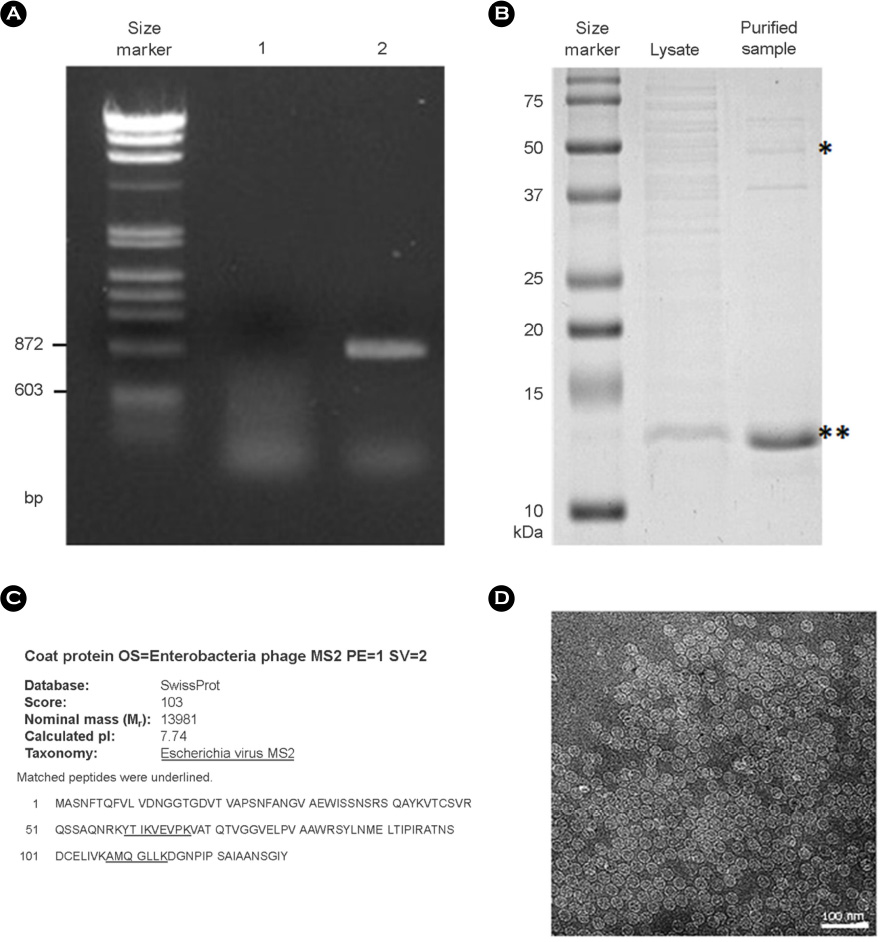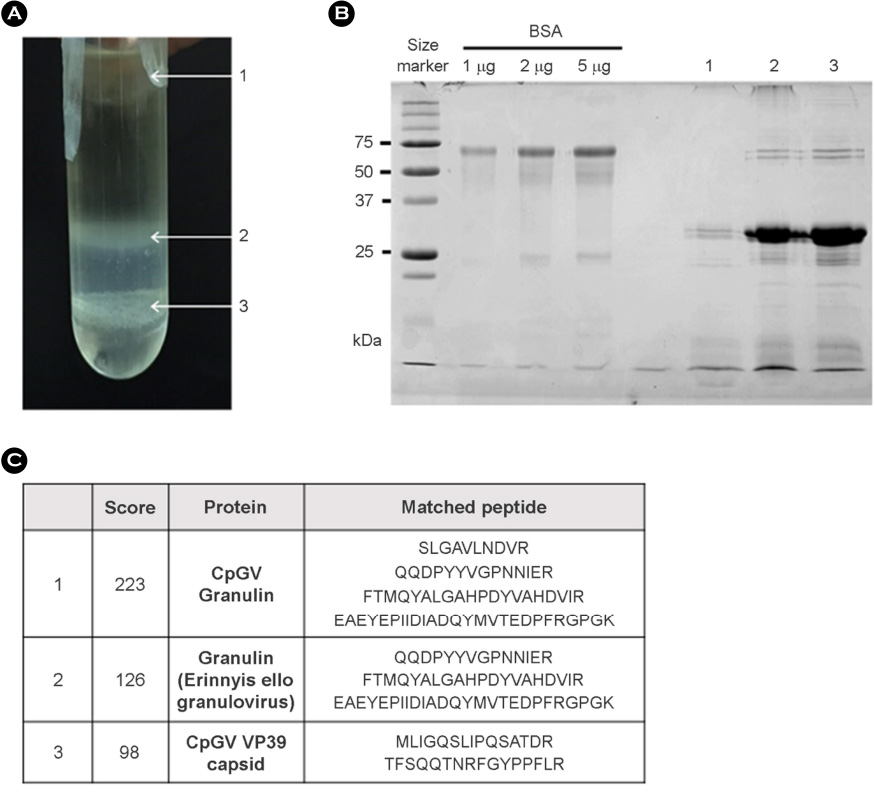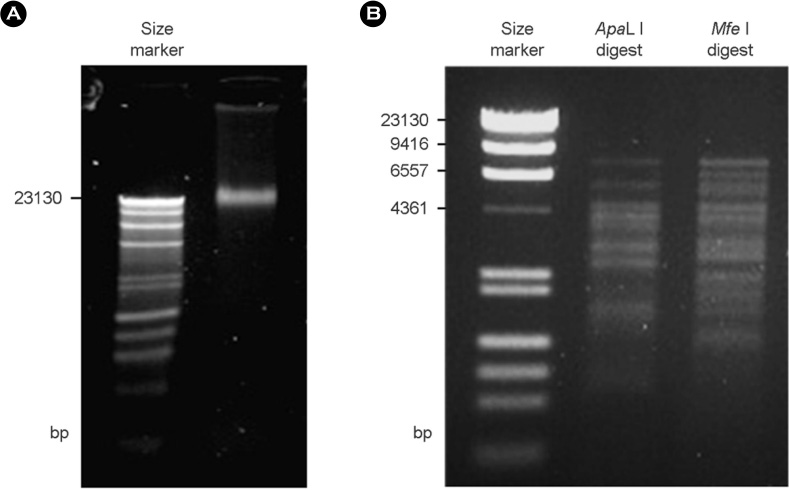J Bacteriol Virol.
2018 Jun;48(2):37-48. 10.4167/jbv.2018.48.2.37.
Production and Storage of Virus Simulants
- Affiliations
-
- 1School of Life Sciences, Chungbuk National Univrersity, Cheongju, Korea. tjcho@chungbuk.ac.kr
- 2Bioneer Corp., Daejeon, Korea.
- 3The 5th Research and Development Institute, Agency for Defense Development, Daejeon, Korea.
- KMID: 2414854
- DOI: http://doi.org/10.4167/jbv.2018.48.2.37
Abstract
- We have examined isolation and identification protocols for three virus simulant candidates to biological warfare agents. MS2 phage, a simulant for yellow fever virus and Hantaan virus, was propagated using as a host an E. coli strain with F pilus. MS2 phage genome was examined by reverse transcription and polymerase chain reaction (RT-PCR). Coat protein of the phage preparation was examined by SDS-polyacrylamide gel electrophoresis (SDS-PAGE) and mass spectrometric analysis. Cydia pomonella granulosis virus (CpGV) is a virus simulant candidate to smallpox virus. CpGV was isolated from a commercialized CpGV pellet. In this study, we developed new isolation and identification protocols for CpGV. One disadvantage of using CpGV is that it is not easy to determine viability of the virus. Here, we have included T4 phage as an alternative. We established a high titer production protocol and developed an easy genome identification protocol that does not require purified phage DNA. Stability of these virus preparations was also examined under various storage conditions. When the virus preparations were not subjected to freeze drying, MS2 phage was most stable when it was stored in liquid nitrogen but unstable at 4℃. In contrast, T4 phage was most stable when it was stored at 4℃. CpGV was stable at −20℃ but not at 4℃. Stability during or after freeze drying was also investigated. The result showed that 70~80% MS2 survived the freeze drying process. In contrast, only about 15% of T4 phage survived during the freeze drying. CpGV was found to be degraded during freeze drying.
Keyword
MeSH Terms
Figure
Reference
-
1. Gubser C, Hué S, Kellam P, Smith GL. Poxvirus genomes: a phylogenetic analysis. J Gen Virol. 2004; 85:105–117.
Article2. Wasserman S, Tambyah PA, Lim PL. Yellow fever cases in Asia: primed for an epidemic. Int J Infect Dis. 2016; 48:98–103.
Article3. Kim HY. Hemorrhagic fever with renal syndrome. Infect Chemother. 2009; 41:323–332.
Article4. Bentahir M, Laduron F, Irenge L, Ambroise J, Gala JL. Rapid and efficient filtration-based procedure for separation and safe analysis of CBRN mixed samples. PLos One. 2014; 9:e88055.
Article5. Dawson DJ, Paish A, Staffell LM, Seymour IJ, Appleton H. Survival of viruses on fresh produce, using MS2 as a surrogate for norovirus. J Appl Microbiol. 2005; 98:203–209.
Article6. Garnier L, Gaudin JC, Bensadoun P, Rebillat I, Morel Y. Real-time PCR assay for detection of a new simulant for poxvirus biothreat agents. Appl Environ Microbiol. 2009; 75:1614–1620.
Article7. Leiman PG, Kanamaru S, Mesyanzhinov VV, Arisaka F, Rossmann MG. Structure and morphogeneis of bacteriophage T4. Cell Mol Life Sci. 2003; 60:2356–2370.8. Grades ZE. Novel isolates of Cydia pomonella granulo virus (CpGV): deciphering the molecular mechanism for overcoming CpGV resistance in codling moth (Cydia pomonella). Germany: Johannes Gutenberg-Universität Mainz;2010. Ph.D. thesis.9. Kuzmanovic DA, Elashvili I, Wick C, O'Connell C, Krueger S. Bacteriophage MS2: Molecular weight and spatial distribution of the protein and RNA components by small-angle neutron scattering and virus counting. Structure. 2003; 11:1339–1348.10. Winstanley D, Crook NE. Replication of Cydia pomonella granulosis virus in cell cultures. J Gen Virol. 1993; 74:1599–1609.11. Jończyk E, Klak M, Międzybrodzki R, Górski A. The infuence of external factors on bacteriophages-review. Folia Microbiol. 2011; 56:191–200.
Article12. Ackermann HW, Tremblay D, Moineau S. Long-term bacteriophage preservation. WFCC Newslett. 2004; 38:35–40.13. Hilton S, Winstanley D. Identification and functional analysis of the origins of DNA replication in the Cydia pomonella granulo virus genome. J Gen Virol. 2007; 88:1496–1504.
Article14. Gebhardt MM, Eberle KE, Radtke P, Jehle JA. Baculovirus resistance in codling moth is virus isolate-dependent and the consequence of a mutation in viral gene pe38. Proc Natl Acad Sci U S A. 2014; 111:15711–15716.
Article15. Merabishvili M, Vervaet C, Pirnay JP, Vos DD, Verbeken G, Mast J, et al. Stability of Staphylococcus aureus phage ISP after freezing-drying (lyophilization). PLoS One. 2013; 8:e68797.16. Jepson CD, March JB. Bacteriophage lambda is a highly stable DNA vaccine delivery vehicle. Vaccine. 2004; 22:2413–2419.
Article17. Puapermpoonisiri U, Ford SJ, van der Walle CF. Stabilization of bacteriophage during freeze drying. Int J Pharm. 2010; 389:168–175.
Article
- Full Text Links
- Actions
-
Cited
- CITED
-
- Close
- Share
- Similar articles
-
- Experimental Study on Freeze Dried B.C.G. Vaccine Production
- Differential Signaling and Virus Production in Calu-3 Cells and Vero Cells upon SARS-CoV-2 Infection
- Prevention of Viral Hepatitis and Vaccination
- A Simulation Study on Microbiological Evaluation of Kimbap Manufacturing Process in Summer and Winter
- Studies on the Epstein-Barr virus transformed human B-lymphocytes2. production of LT-like factor by Epstein-Barr virus transformed human B-lymphocytes





